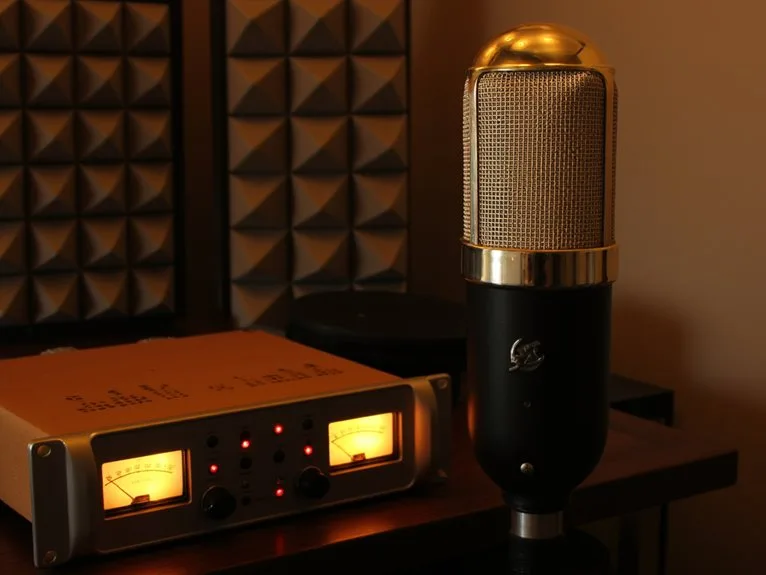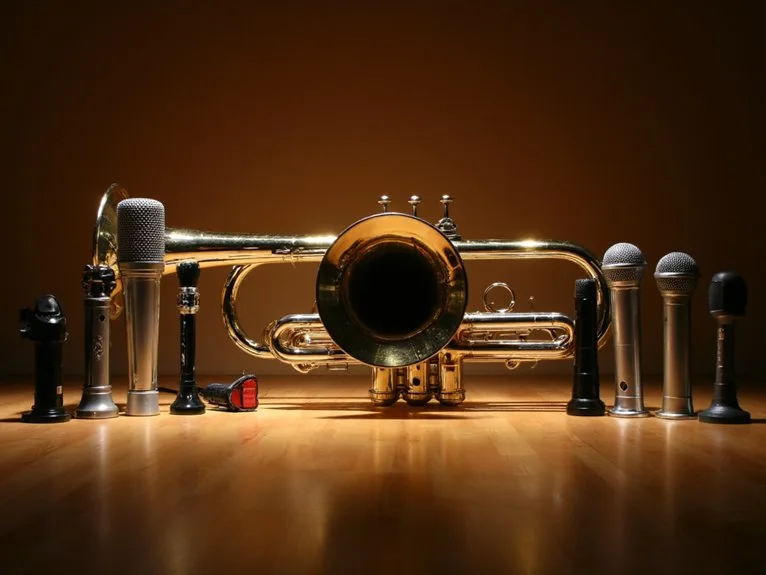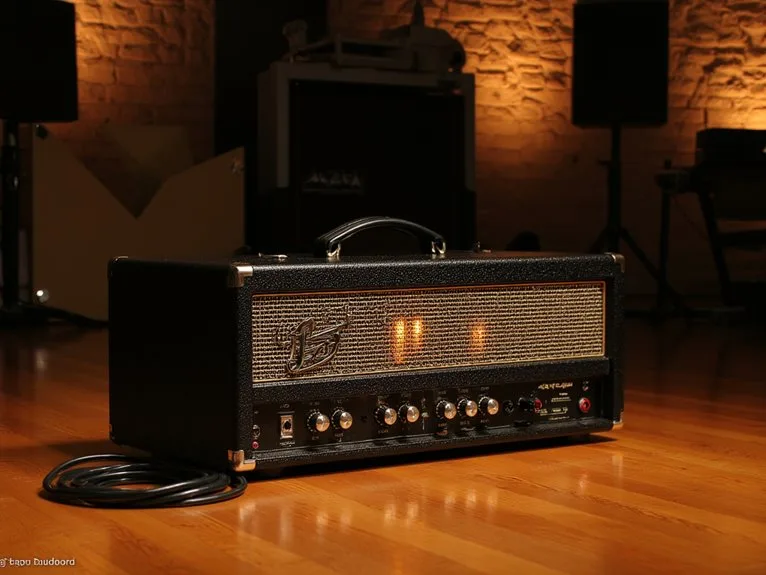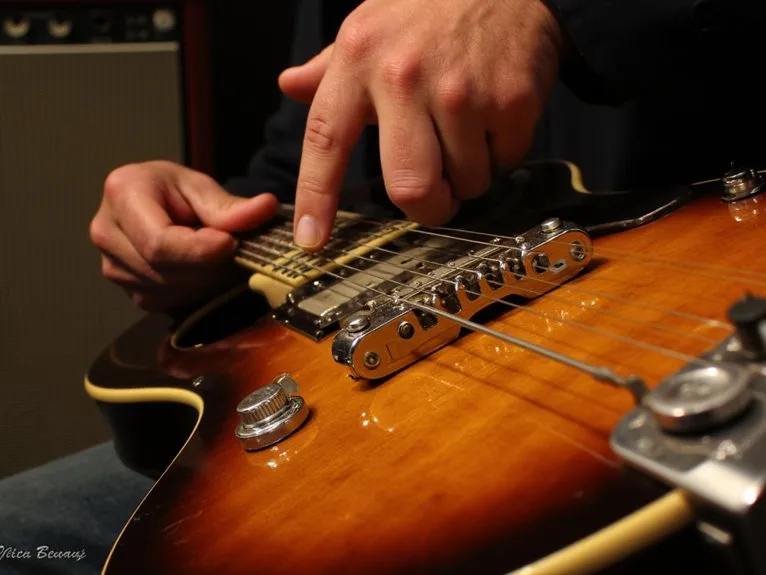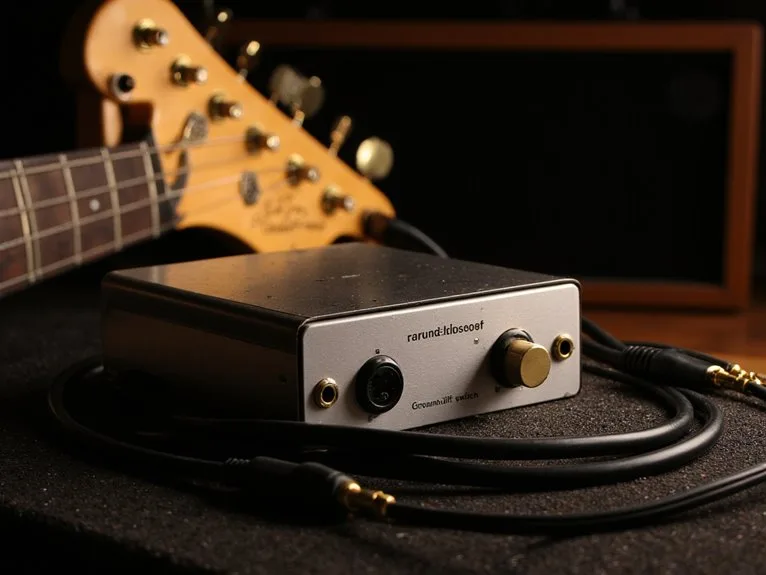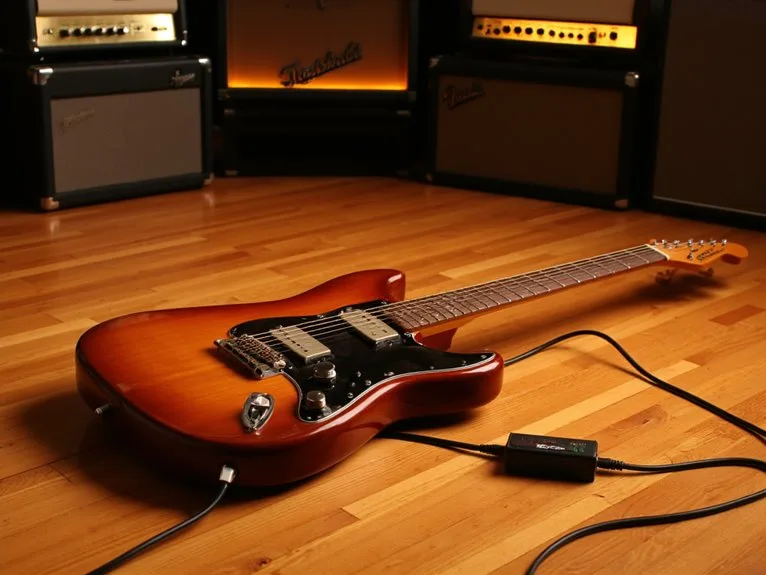Understanding Microphone Frequency Response
Microphone frequency response measures how accurately your mic captures sound across the 20 Hz to 20,000 Hz spectrum, with flat response curves providing neutral reproduction while shaped curves add tonal coloring. Dynamic mics excel at handling high sound pressure from drums, while condensers offer studio sensitivity with their electrostatic conversion. You’ll notice proximity effect boosts bass below 200 Hz in directional mics, and off-axis positioning creates high-frequency roll-off that affects tonal integrity—understanding these characteristics becomes essential for ideal microphone selection.
We are supported by our audience. When you purchase through links on our site, we may earn an affiliate commission, at no extra cost for you. Learn more.
Notable Insights
- Frequency response measures how accurately a microphone captures sound across the 20 Hz to 20,000 Hz range of human hearing.
- Flat frequency response curves are preferred in professional settings to avoid unwanted sound coloration and ensure accurate reproduction.
- Dynamic microphones excel with percussive instruments due to high sound pressure handling, while condensers offer superior studio sensitivity.
- Polar patterns affect frequency capture, with cardioid mics showing high-frequency roll-off at 45-degree angles and proximity effect boosting bass.
- Environmental factors like temperature and humidity significantly influence microphone frequency response, requiring proper storage and regular calibration.
What Is Microphone Frequency Response?
Understanding frequency response becomes essential when you’re selecting a microphone, because this characteristic determines how accurately your mic will capture and reproduce the full spectrum of sound frequencies that reach it.
Your microphone’s frequency response represents the range of sound frequencies it can detect and reproduce, typically measured in Hertz and spanning roughly 20 Hz to 20,000 Hz to match human hearing capabilities. This specification reveals your mic’s microphone sensitivity across various frequency bands, showing whether it emphasizes certain frequencies or maintains neutral reproduction. For percussive instruments like floor toms, dynamic microphones are often preferred because they handle high sound pressure levels effectively while maintaining good frequency response characteristics.
The frequency range isn’t just about coverage though, since many microphones intentionally color sound by boosting presence frequencies around 3 kHz for clarity, or rolling off low frequencies below 80 Hz to reduce handling noise and rumble. When evaluating microphones, look for models with a signal-to-noise ratio of 75dB or higher to ensure clear audio reproduction across the frequency spectrum. Additionally, your microphone’s response will be influenced by room acoustics, as even a flat-response microphone can capture unwanted reflections and reverberation that affect the overall sound quality. These variations in frequency response directly influence sound characteristics, affecting everything from vocal warmth to instrumental definition in your recordings.
The Science Behind Sound Wave Conversion
When you speak into a microphone, you’re witnessing a remarkable transformation where acoustic energy becomes electrical signals through precise mechanical processes that most people never think about.
Your voice creates pressure waves that strike the microphone’s diaphragm, causing it to vibrate in exact correspondence with the sound’s frequency and amplitude characteristics. These pressure variations represent small fluctuations from the equilibrium atmospheric pressure, with the microphone’s diaphragm responding to even minimal pressure changes that are barely perceptible compared to normal air pressure.
The microphone then converts these physical movements into electrical variations through electromagnetic induction or capacitance changes, depending on whether you’re using a dynamic or condenser design. Most microphones are designed to capture the 20 to 20,000 Hz range that corresponds to typical human hearing capabilities. Flat response curves are preferred in professional recording applications to avoid unwanted coloration and ensure accurate sound reproduction across the entire frequency spectrum.
Understanding how different microphone types handle this conversion process helps explain why dynamic microphones are particularly valued for their warm clarity and durability in both studio and live performance environments.
Mechanical to Electrical Conversion
As sound waves collide with a microphone’s diaphragm, they trigger a fascinating chain of events that transforms invisible air pressure variations into measurable electrical signals through precise electromechanical transduction.
You’ll find two primary conversion methods dominate the landscape: electromagnetic induction in dynamic microphones, where a coil moves within a permanent magnetic field to generate current, and electrostatic conversion in condenser microphones, where diaphragm vibrations alter capacitance between charged plates.
The mechanical coupling efficiency directly impacts microphone sensitivity, as your diaphragm’s vibration amplitude and frequency determine the electrical output’s characteristics. Enhanced sound wave movement can be achieved by incorporating helium gas into the microphone design, as the higher speed of sound in helium compared to air improves the acoustic response characteristics.
Material properties, construction geometry, and internal amplification stages all influence transducer efficiency, affecting how faithfully your microphone captures sound waves and converts them into usable electrical signals for recording or amplification purposes. Dynamic microphones exhibit resonance frequencies typically ranging from 150 to 800 Hz, which affects their frequency response characteristics and overall performance.
Diaphragm Response Characteristics
Behind every microphone’s ability to capture sound lies its diaphragm—a thin, precisely engineered membrane that determines how faithfully your recordings translate air pressure variations into electrical signals.
Understanding diaphragm behaviors reveals why some microphones excel at capturing vocals while others shine on instruments, with stiffness controlling low-frequency response, mass dominating high frequencies, and resonance determining the shift point between these regions. Resonance arises from the interaction between the diaphragm’s mass and compliance, requiring careful damping to control unwanted movement at the resonant frequency.
You’ll notice frequency limitations emerge from these physical properties—larger diaphragms move more air for broader spectrum capture but sacrifice high-frequency precision, while smaller membranes deliver detailed treble response at the expense of low-end warmth. Different microphone designs, including condenser mics, ribbon mics, and dynamic mics, utilize varying diaphragm technologies that directly influence their frequency response characteristics.
The diaphragm’s mechanical characteristics, including damping and resonant frequency placement, ultimately shape your microphone’s tonal signature and suitability for specific recording applications.
Reading Frequency Response Specifications
While I’ve spent countless hours explaining microphone technology to audio engineers and enthusiasts, I’ve noticed that frequency response specifications remain one of the most misunderstood aspects of microphone selection, despite being potentially the most critical factor in determining how your recordings will actually sound.
When you’re conducting frequency response analysis, you’ll encounter graphs plotting Hz on the horizontal axis against dB on the vertical, revealing how your mic actually behaves across the audible spectrum. These specifications typically include tolerance ratings like ±2 dB, which define acceptable deviation from the manufacturer’s intended response curve. Understanding these response curves helps prevent feedback issues, as abrupt peaks and valleys create greater tendency for unwanted oscillation in your audio system.
Smart microphone selection criteria should prioritize understanding these graphs over flashy marketing claims, since peaks and dips directly impact your sound’s tonal character and recording quality. Many professional microphones feature presence boosts around 6 kHz that enhance vocal clarity and articulation in recordings. Quality condensers typically capture the full 20Hz-20kHz range to ensure comprehensive frequency reproduction for professional applications. It’s important to recognize that tailored frequency responses can actually improve intelligibility rather than seeking perfectly flat response curves, which aren’t always optimal for every application.
How Diaphragm Materials Affect Response
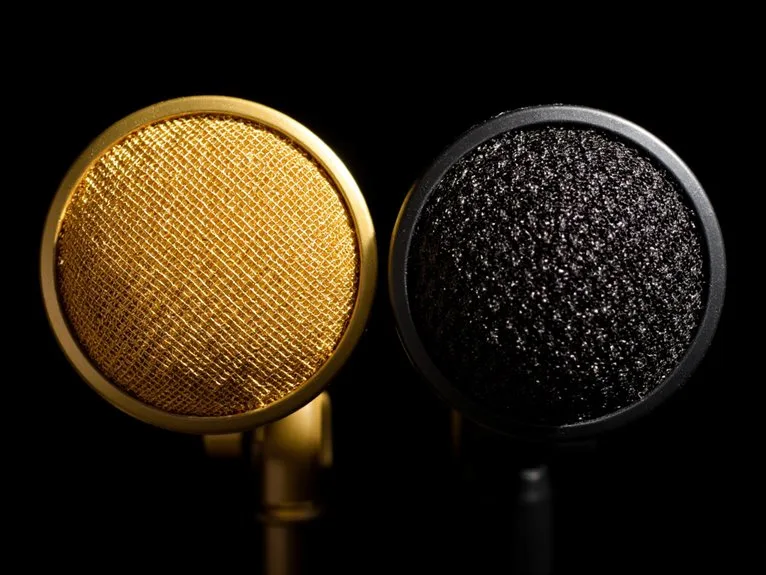
After years of testing countless microphones across studios and live venues, I’ve discovered that the diaphragm material represents the single most critical factor determining a microphone’s frequency response characteristics.
Understanding diaphragm dynamics involves recognizing how material properties directly influence what you’ll hear in your recordings.
The material trade offs you’ll encounter when selecting microphones include:
- Mylar diaphragms deliver reliable, broad frequency response with excellent damping characteristics that prevent unwanted resonance peaks.
- Metalized materials add durability and conductivity but increase mass, subtly affecting high-frequency sensitivity and transient response.
- Exotic materials like titanium or beryllium extend ultra-high frequency response dramatically but come with considerably higher costs.
Your microphone’s sensitivity, durability, and frequency flatness depend entirely on how manufacturers balance these competing material characteristics for specific applications.
The Role of Polar Patterns in Frequency Capture
When you’re selecting a microphone, the polar pattern doesn’t just determine which directions it picks up sound from—it fundamentally shapes how different frequencies are captured, creating distinct tonal characteristics that can make or break your recording. Understanding the various types of microphone polar patterns is essential for achieving the desired sound quality in any recording situation. A microphone polar patterns overview reveals how each pattern, whether it’s omnidirectional, cardioid, or figure-eight, interacts with both the source of sound and the surrounding environment. Choosing the right polar pattern helps to minimize unwanted noise and emphasizes the desired audio, ensuring a polished final product.
I’ve noticed that many people overlook how these directional patterns create varying proximity effects, where getting closer to certain mic types can dramatically boost low frequencies in ways that omnidirectional models simply won’t exhibit.
What’s particularly fascinating is how off-axis frequency response changes based on your chosen pattern, meaning sounds hitting the microphone from the sides or rear will be colored differently depending on whether you’re using a cardioid, figure-8, or omnidirectional capsule. Cardioid patterns are especially effective for isolating specific sound sources and rejecting ambient noise while maintaining excellent frequency response characteristics.
For optimal clarity across the audible spectrum, professional omnidirectional microphones typically maintain a frequency response of 20Hz-20kHz, ensuring accurate capture of both the deepest bass frequencies and the most delicate high-frequency details in your recordings.
Directional Sound Collection Patterns
Although frequency response gets most of the attention when we’re evaluating microphones, I’d argue that polar patterns play an equally significant role in determining how your recordings actually sound.
When you’re positioning different microphone types, you’re fundamentally sculpting the sonic landscape through directional sensitivity, which directly impacts how frequencies reach your capsule from various angles.
Here’s what you need to understand about directional patterns:
- Your cardioid mic’s rear rejection isn’t just blocking sound—it’s eliminating potential frequency coloration
- Off-axis capture changes your tone color, often in ways you didn’t anticipate
- The proximity effect varies dramatically between recording techniques based on pattern choice
On-axis positioning delivers consistent frequency response, while off-axis sounds introduce coloration that can make or break your recording’s tonal integrity.
Proximity Effect Variations
Your microphone’s polar pattern doesn’t just determine which directions it captures sound from—it fundamentally controls how proximity effect shapes your frequency response. I’ve learned this lesson the hard way through countless sessions where bass buildup caught me completely off guard.
These proximity variations become dramatically apparent when you compare different directional microphones at close range, with figure-of-eight patterns delivering the most aggressive low-frequency boost, while cardioids provide moderate enhancement.
The polar differences create distinct sonic signatures because gradient-based designs amplify those curved low-frequency wavelengths that occur near sound sources, whereas omnidirectional mics remain unaffected since they don’t rely on pressure gradients.
Understanding these variations helps you strategically choose patterns that either enhance warmth or maintain neutral response.
Off-Axis Frequency Response
While proximity effect focuses on what happens when sound sources move closer to your microphone, off-axis frequency response reveals how your mic’s polar pattern dramatically alters the tonal character of sounds arriving from different angles.
I’ve discovered that this phenomenon can either save your recording or completely sabotage it depending on your awareness.
Your microphone’s sensitivity variations create distinct tonal shifts as sound sources move away from the primary axis, causing off axis coloration that can add unwanted harshness or muddiness to your recordings.
Here’s what you’ll experience with different polar patterns:
- Cardioid microphones introduce subtle high-frequency roll-off at 45-degree angles, creating warmer but less detailed sound.
- Omnidirectional patterns maintain consistent frequency response regardless of angle, preserving natural tonal balance.
- Bi-directional microphones exhibit pronounced side rejection, dramatically reducing sensitivity and altering frequency characteristics at 90-degree positions.
Maintaining Frequency Response Over Time
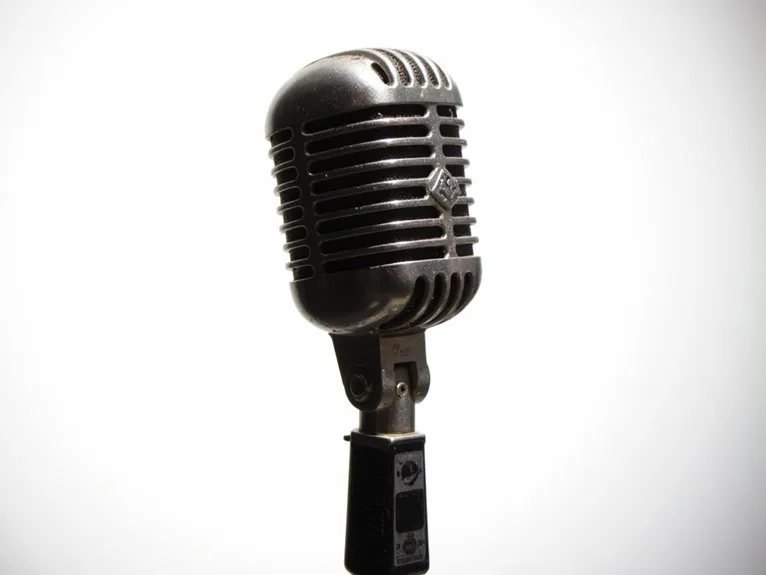
While many audio enthusiasts focus on selecting the perfect microphone for their initial setup, I’ve learned through years of recording experience that maintaining that carefully chosen frequency response requires ongoing attention to several key factors.
Your microphone’s performance degrades silently over time, and without proper calibration techniques, you’ll gradually lose that pristine sound quality you initially purchased. Here’s what threatens your investment:
- Component aging – diaphragms lose elasticity, causing subtle tonal shifts that accumulate imperceptibly.
- Environmental damage – humidity, dust, and temperature fluctuations slowly degrade internal materials.
- Physical wear – poor handling practices stress connectors and capsules, introducing unwanted frequency attenuation.
I recommend annual calibration using specialized reference equipment, alongside protective storage in controlled environments.
Professional handling practices, including proper cases and windscreen usage, preserve your microphone’s original frequency characteristics far longer than casual maintenance approaches.
Frequently Asked Questions
Can Smartphone Apps Accurately Measure Microphone Frequency Response for Home Users?
Smartphone apps can’t accurately measure microphone frequency response for home users due to inherent limitations in built-in microphones, which lack the precision needed for detailed frequency analysis.
While app accuracy improves considerably with external calibrated microphones, this compromises user convenience since you’ll need additional equipment, technical knowledge, and calibration procedures that most home users find impractical for basic frequency response measurements.
Do Wireless Microphone Systems Alter the Original Frequency Response Characteristics?
Yes, wireless technology does alter your microphone’s original frequency response characteristics, though I’ve found high-quality systems minimize these changes considerably.
The RF transmission process, analog-to-digital conversions, and built-in processing circuits can introduce subtle coloration, phase shifts, or frequency roll-offs that affect audio fidelity.
While premium wireless systems preserve most of the original response curve, you’ll always get more consistent frequency accuracy with wired connections.
How Does Room Acoustics Interact With Microphone Frequency Response During Recording?
Room reflections dramatically alter your microphone’s frequency response by creating peaks and dips that weren’t present in the original anechoic specifications.
Hard surfaces bounce high frequencies back, causing comb filtering effects, while low-frequency room modes boost or cancel bass frequencies unpredictably.
Sound absorption materials help minimize these reflections, allowing your microphone to capture more accurate representations of the source material without unwanted acoustic coloration.
Are Expensive Microphones Always Better Than Budget Options for Frequency Accuracy?
I’ve found that expensive microphones aren’t always superior for frequency accuracy, as price performance depends heavily on your specific needs and microphone design quality.
You’ll discover diminishing returns beyond certain price points, where budget options can deliver acceptable frequency response for non-critical applications like streaming or casual recording, while premium models excel in professional scenarios requiring precise tonal accuracy.
Can Software EQ Completely Compensate for Poor Microphone Frequency Response?
You can’t rely on software EQ to completely fix poor microphone frequency response due to significant software limitations that affect overall eq effectiveness.
While EQ helps correct some frequency imbalances, it can’t address phase response issues, transient behavior problems, or extreme dips without introducing noise and distortion.
I’ve found that excessive compensation often creates synthetic-sounding results, making proper microphone selection far more important than post-processing fixes.
On a final note
Now that you’ve explored frequency response fundamentals, measurement standards, and real-world applications, you’re equipped to make informed microphone decisions for your specific needs. Whether you’re tracking vocals in a treated studio, reinforcing live performances, or capturing ambient soundscapes, understanding how different mics handle various frequencies will dramatically improve your audio quality. Remember, there’s no perfect microphone the right tool for each particular recording situation you encounter.

